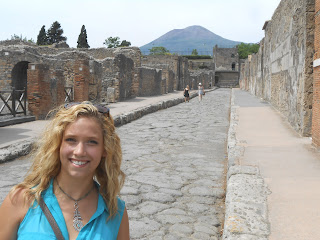The Shady Side:
Aside from the gigantic houses and
fantastic gardens of the rich and powerful, life in Pompeii before the eruption
of Vesuvius in 79 AD was likely not as glamorous for those who didn’t belong to
the Patrician upper classes. The streets were filthy, filled with sewage and
refuse thrown from the surrounding homes and animal drawn carts. This concept can be demonstrated by the
large stepping stones still present today, that allowed citizens to pass over
the lowered road and on to raised sidewalks in order to avoid the filth. The
sight however, would have had no comparison with the stench. Judging by the beating sun and intense
heat while touring the site, I can only imagine how disgusting the streets must
have been. The deep marks left in
the roads by the wagon wheels suggest a wider use of the lowered road for
transport other than by foot.
Also considered to be a slightly less savory aspect of
Pompeii is its definitive mark of sexual promiscuity. With estimates of the presence of nearly 40 brothels, it is
evident that this type of elicit behavior was a common occurrence. It should be
said however, that early excavations of the site deemed any structure
containing erotic artwork as a brothel.
As it was not uncommon for Romans to have these types of erotic scenes
and phallic symbols in their homes, the estimated number may be slightly high,
and most of the known brothels are simply rooms above stores or
apartments. In Pompeii, the largest and most famous
brothel is the Lupanar on the Vico del Lupunare. A Lupanar, Latin for brothel
(literally “den of she-wolves”) housed Lupas, slang for prostitutes. In the Lupanar, there are very small
rooms with stone beds which may have had a thin cushion. Above the doorways of the rooms are
wall paintings depicting the various services that were offered at the
particular location, and customers often voiced their opinions of the girls in
lewd graffiti that can still be found on some of the walls. Female children in Roman society were
not desired to the level of males they were not a suffiencient heirs to the
family line. Thus, many young
girls were abandoned and left to prostitution, a fate that may have been relatively
common in Pompeii.
Bringing the City to
Light:
Excavation of Pompeii began in 1748, in an effort to obtain
artwork for the collection of Bourbon king Charles III. As a result of this, many of the
beautiful mosaics and wall paintings had been destroyed or severely damaged,
however many remain in the Museo Notational in Napoli. Over several centuries, various teams
of archaeologists have worked to uncover the lost city of Pompeii, a task that
may not be as difficult as one would think because the volcanic debris covering
the site was light and not compact.
One of the most famous archaeologists was Giuseppe Fiorelli, who employed an excavation
technique working from top to bottom in order to better preserve the
remains. Fiorelli also
developed the use of the plaster casts, made using the forms left from the
decayed bodies covered in volcanic ash to recreate the states of those victim
to the fateful eruption. Today,
almost 70% of Pompeii has been excavated and there is a continuous effort to
restore the uncovered remains.
Many believe it is necessary to leave the other 30% beneath the volcanic
debris in order to preserve Pompeii’s fateful legacy for future generations.
When I took my first steps on to the almost perfectly
preserved road that led into Pompeii, I felt an overwhelming feeling of awe. I had hoped to come here since I was in
grade school, with a strong interest in Roman history and archaeology, and it
was everything I had imagined and more.
Mount Vesuvius stood looming over the ruins, a fateful reminder of the
devastation that happened here. As
I walked through the streets and saw the plaster body castings it felt
incredibly surreal. I can’t even
imagine the terror the citizens must have felt as the volcano erupted into an
enormous pillar, followed by an intense heat wave, and finally showers of
volcanic ash and gaseous air that would have eventually smothered them. These people had no recognizable
warning, and no explanation for what was happening to them. Unidentified distant booming sent a bit
of shiver up my spine today as we traversed the ancient town, as Vesuvius is
still an active volcano. From
start to finish, roads, ruins and people, Pompeii was not a sight that I will
not soon forget.
~Alissa Douglass



I was there in Pompei in about '68, when I was probably your age. I was in awe,too. Now I am nearly 66 and am glad you are doing this research. I would love to include a small quote from your work in a book I am writing that includes a chapter on female sexuality transforming in the American sexual revolution that I was part of. See my website www.taoTLC.com Contact me if you have an objection to a quote.
ReplyDelete